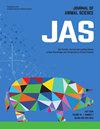Effects of starter diets with different NDF levels on gastrointestinal tract development, microbial profiles, nutrient digestibility, and growth performance in Xinong Saanen dairy goat kids
IF 2.9
2区 农林科学
Q1 AGRICULTURE, DAIRY & ANIMAL SCIENCE
引用次数: 0
Abstract
Starter feeds in pre-ruminant diets help optimize ruminal development before weaning, contributing significantly to lifelong health and performance. This study investigated the effects of varying neutral detergent fiber (NDF) levels in starter diets on growth, serum indices, slaughter performance, nutrient digestibility, gastrointestinal tract (GIT) development, and microbial profiles of dairy goat kids. Sixty 14-day-old Xinong Saanen dairy goat kids were assigned to three groups (n = 20/group) with NDF levels of 20%, 25%, or 30%. All kids received milk and starters from day 15 to day 84. Body weight (BW) was monitored bi-weekly, and blood was sampled at weeks 2, 6, 10, and 12. At 12 weeks, three male kids per group were slaughtered for GIT morphology, enzyme activity, microbial profiles, and carcass assessment. The 25N and 30N groups exhibited significantly greater overall BW (P < 0.01) and serum aspartate transaminase (AST) (P < 0.01) and β-hydroxybutyric acid (BHBA) (P < 0.01). Dressing percentage, duodenum mass, jejunum mass and total small intestine mass increased linearly (P < 0.05) with higher NDF levels. The ruminal papilla length (P < 0.05) and papilla width (P < 0.05), the villus height /crypt depth (VH/CD) of jejunum (P < 0.01) and the mucosal thickness (P < 0.01) of ileum also increased linearly as dietary NDF levels increased. Enzyme activities, such as cellulase in the rumen (P = 0.071) and small intestine (P = 0.075) tended to increase with increasing NDF content, whereas α-amylase in the rumen (P < 0.05) and small intestine (P < 0.05), pepsin in the rumen (P < 0.01) and trypsin in the small intestine (P < 0.05) decreased. Increasing NDF levels resulted in linear responses (P < 0.05) in ruminal acetate, butyrate, acetate/propionate (A/P) ratio and total volatile fatty acid (TVFA) concentrations. In the rumen, Lachnospiraceae_UCG-010 and norank_f_UCG-010_o__Oscillospirales, fibrolytic microorganisms was more abundant in the 30N group while Succinivibrio, a saccharolytic bacteria was enriched in the 20N group. In the jejunum, norank_o__Clostridia_vadinBB60_group and unclassified_f__Lachnospiraceae, were enriched in the 25N and 30N groups. In contrast, Candidatus_Arthromitus, Mitsuokella, and norank_f__F082, involved in host immunity, were significantly enriched in the 20N group. Overall, starters containing 25% and 30% NDF promoted fiber-degrading bacteria and enhanced GIT development, thereby optimizing the growth performance of dairy goat kids.不同NDF水平的起始日粮对西农萨嫩奶山羊胃肠道发育、微生物特征、营养物质消化率和生长性能的影响
前反刍动物日粮中的起始饲料有助于优化断奶前的瘤胃发育,对终生健康和生产性能有显著贡献。本试验旨在研究犊牛日粮中不同中性洗涤纤维(NDF)水平对奶山羊生长、血清指标、屠宰性能、营养物质消化率、胃肠道发育和微生物谱的影响。60只14日龄西农沙嫩奶山羊按NDF水平分别为20%、25%和30%分为3组(n = 20/组)。从第15天到第84天,所有的孩子都得到了牛奶和开胃菜。每两周监测体重(BW),并于第2、6、10和12周采血。12周时,每组屠宰3只雄性幼仔进行胃肠道形态、酶活性、微生物谱和胴体评估。25N和30N组的总体重显著高于对照组(P <;0.01)和血清天冬氨酸转氨酶(AST) (P <;0.01)和β-羟基丁酸(BHBA) (P <;0.01)。屠宰率、十二指肠质量、空肠质量和小肠总质量线性增加(P <;0.05), NDF水平较高。瘤胃乳头长度(P <;0.05)和乳头宽度(P <;0.05),空肠绒毛高度/隐窝深度(VH/CD) (P <;0.01)、粘膜厚度(P <;随着饲粮NDF水平的升高,回肠的回肠率也呈线性升高。随着NDF含量的增加,瘤胃纤维素酶(P = 0.071)和小肠纤维素酶(P = 0.075)活性有升高的趋势,瘤胃α-淀粉酶(P < lt;0.05)和小肠(P <;0.05),瘤胃胃蛋白酶(P <;0.01)和小肠胰蛋白酶(P <;0.05)下降。增加NDF水平导致线性反应(P <;0.05)对瘤胃乙酸、丁酸、乙酸/丙酸(A/P)比和总挥发性脂肪酸(TVFA)浓度的影响。在瘤胃中,Lachnospiraceae_UCG-010和norank_f_UCG-010_o__Oscillospirales中,纤维分解微生物在30N组中数量较多,而糖溶菌Succinivibrio在20N组中数量较多。在空肠中,25N和30N处理下,norank__clostridia_vadinbb60_group和unclassified__lachnospiraceae富集。与此相反,参与宿主免疫的Candidatus_Arthromitus、Mitsuokella和norank_f__F082在20N组显著富集。综上所述,添加25%和30% NDF的发酵剂促进了纤维降解菌的生长,促进了GIT的发育,从而优化了奶山羊的生长性能。
本文章由计算机程序翻译,如有差异,请以英文原文为准。
求助全文
约1分钟内获得全文
求助全文
来源期刊

Journal of animal science
农林科学-奶制品与动物科学
CiteScore
4.80
自引率
12.10%
发文量
1589
审稿时长
3 months
期刊介绍:
The Journal of Animal Science (JAS) is the premier journal for animal science and serves as the leading source of new knowledge and perspective in this area. JAS publishes more than 500 fully reviewed research articles, invited reviews, technical notes, and letters to the editor each year.
Articles published in JAS encompass a broad range of research topics in animal production and fundamental aspects of genetics, nutrition, physiology, and preparation and utilization of animal products. Articles typically report research with beef cattle, companion animals, goats, horses, pigs, and sheep; however, studies involving other farm animals, aquatic and wildlife species, and laboratory animal species that address fundamental questions related to livestock and companion animal biology will be considered for publication.
 求助内容:
求助内容: 应助结果提醒方式:
应助结果提醒方式:


